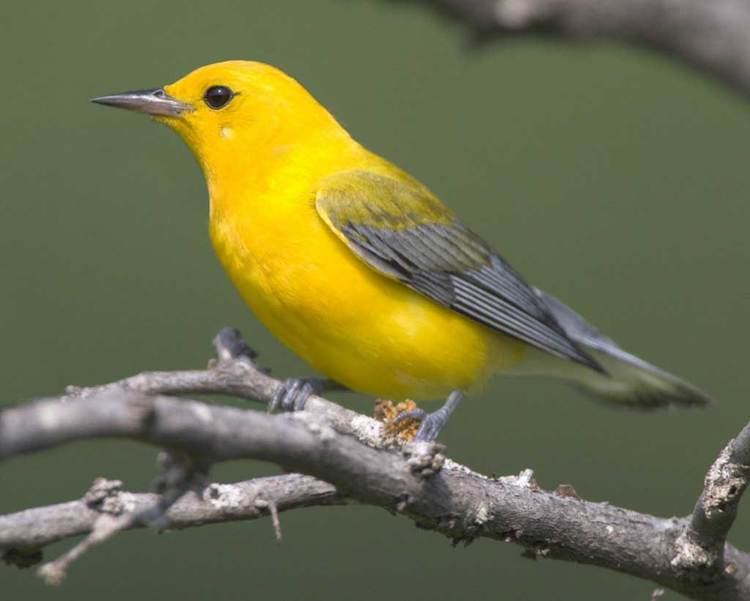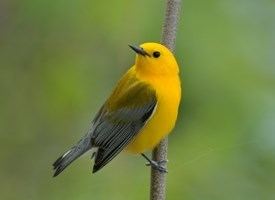Kingdom Animalia Scientific name Protonotaria citrea Higher classification Protonotaria Order Passerine | Family Parulidae Phylum Chordata Rank Species | |
 | ||
Genus Protonotaria
Baird, 1858 Similar Hooded warbler, Northern parula, Yellow‑throated warbler, Kentucky warbler, New World warbler | ||
Prothonotary warbler singing in a tree
The prothonotary warbler (Protonotaria citrea) is a small songbird of the New World warbler family. It is the only member of the genus Protonotaria.
Contents
- Prothonotary warbler singing in a tree
- Vcu biology researchers the prothonotary warbler
- Description
- Distribution
- Behavior and ecology
- Status
- In culture
- References

Vcu biology researchers the prothonotary warbler
Description

The prothonotary warbler is 13 cm (5.1 in) long and weighs 12.5 g (0.44 oz). It has an olive back with blue-grey wings and tail, yellow underparts, a relatively long pointed bill and black legs. The adult male has a bright orange-yellow head. Females and immature birds are duller and have a yellow head. In flight from below, the short, wide tail has a distinctive two-toned pattern, white at the base and dark at the tip.
Distribution

It breeds in hardwood swamps in extreme southeastern Ontario and eastern United States. It winters in the West Indies, Central America and northern South America. It is a rare vagrant to western states, most notably California.
Behavior and ecology
It is the only eastern warbler that nests in natural or artificial cavities, sometimes using old downy woodpecker holes. The male often builds several incomplete, unused nests in his territory; the female builds the real nest. It lays 3–7 eggs.
The preferred foraging habitat is dense, woody streams, where the prothonotary warbler forages actively in low foliage, mainly for insects and snails.
The song of this bird is a simple, loud, ringing sweet-sweet-sweet-sweet-sweet. The call is a loud, dry chip, like that of a hooded warbler. Its flight call is a loud seeep.
Status
These birds are declining in numbers due to loss of habitat. They are also parasitized by the brown-headed cowbird (Molothrus ater), or outcompeted for nest sites by the house wren (Troglodytes aedon). It is listed as endangered in Canada. The species persists in protected environments such as South Carolina's Francis Beidler Forest currently home to more than 2,000 pairs, the densest known population.
In culture
This bird was supposedly named after certain prelates in the Roman Catholic Church known as the protonotarii, due to its golden plumage (although protonotaries apostolic wear purple robes). It was once known as the golden swamp warbler.
The prothonotary warbler became known in the 1940s as the bird that, in front of the House Un-American Activities Committee, established a connection between Whittaker Chambers and Alger Hiss. Chambers had testified that Hiss enjoyed bird-watching, and once bragged about seeing a prothonotary warbler. Hiss later testified to the same incident, causing many members to become convinced of the pair's acquaintance.
This bird is mentioned in A Sand County Almanac by Aldo Leopold as the "[J]ewel of my disease-ridden woodlot", "as proof that dead trees are transmuted into living animals, and vice versa. When you doubt the wisdom of this arrangement, take a look at the prothonotary."
John James Audubon's painting of a prothonotary warbler is the third plate in his Birds of America.
